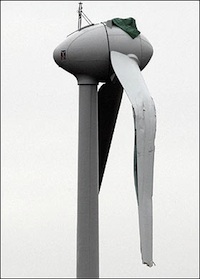This article is more than 1 year old
Acoustic trauma: How wind farms make you sick
It's an ill wind ...
Industrial wind installations are creating a serious health issue, and comprehensive research is urgently needed, says a former Professor of Public Health.
"There has been no policy analysis that justifies imposing these effects on local residents. The attempts to deny the evidence cannot be seen as honest scientific disagreement, and represent either gross incompetence or intentional bias," writes Carl Phillips, formerly Professor of Public Health at University of Alberta, now an independent researcher.
"There is ample evidence that turbines cause a constellation of health problems, and attempts to deny this involve claims that are contrary to proper methods of scientific inference," Phillips writes in a paper published in the Bulletin of Science, Technology, and Society. It's one of several interesting papers in the journal, which is devoted to wind health issues.
Industrial wind installations produce audible and non-audible noise, and optical flicker. But campaigners are fragmented, and face a daunting alliance of big eco-business and government. The academic establishment, which is quick to leap upon public health issues, is strangely inert.
"There is a huge amount of evidence, and it's incredibly convincing," Phillips told us by phone, "but it takes a different form to what industry consultants present."

Empirical studies are rare. Renewable UK, the wind and wave industry lobby group, cites research by the Noise Working Group for the UK business department on its web page devoted to noise issues. The 1996 study, known as ETSU-R-97 (10-page PDF/1.8MB), recommended "Noise from the wind farm should be limited to 5dB(A) above background for both day-time and night-time", and in the Renewable UK portrait, wind farms sound idyllic; like nature, only more so.
"Outside the nearest houses, which are at least 300 metres away, and more often further, the sound of a wind turbine generating electricity is likely to be about the same level as noise from a flowing stream about 50-100 metres away or the noise of leaves rustling in a gentle breeze," the group writes.
Yet the ancient study, completed in 1996 and now so old it's actually in the national archive – has been heavily criticised. Sleep expert Dr Christopher Hanning has written:
"Its major flaws include the use of averaged noise levels over too long a time period and using a best fit curve, thus ignoring the louder transient noise of AM which causes awakenings and arousals. It ignores also the property of low frequency noise to be audible over greater distances than higher frequency noise. By concentrating on sound pressure alone, it ignores the increased annoyance of particular noises, especially that associated with AM. It is also the only guidance anywhere in the world which permits a higher sound level at night than during the day, completely contrary to common sense, noise pollution legislation and WHO guidelines."
[original emphasis]
